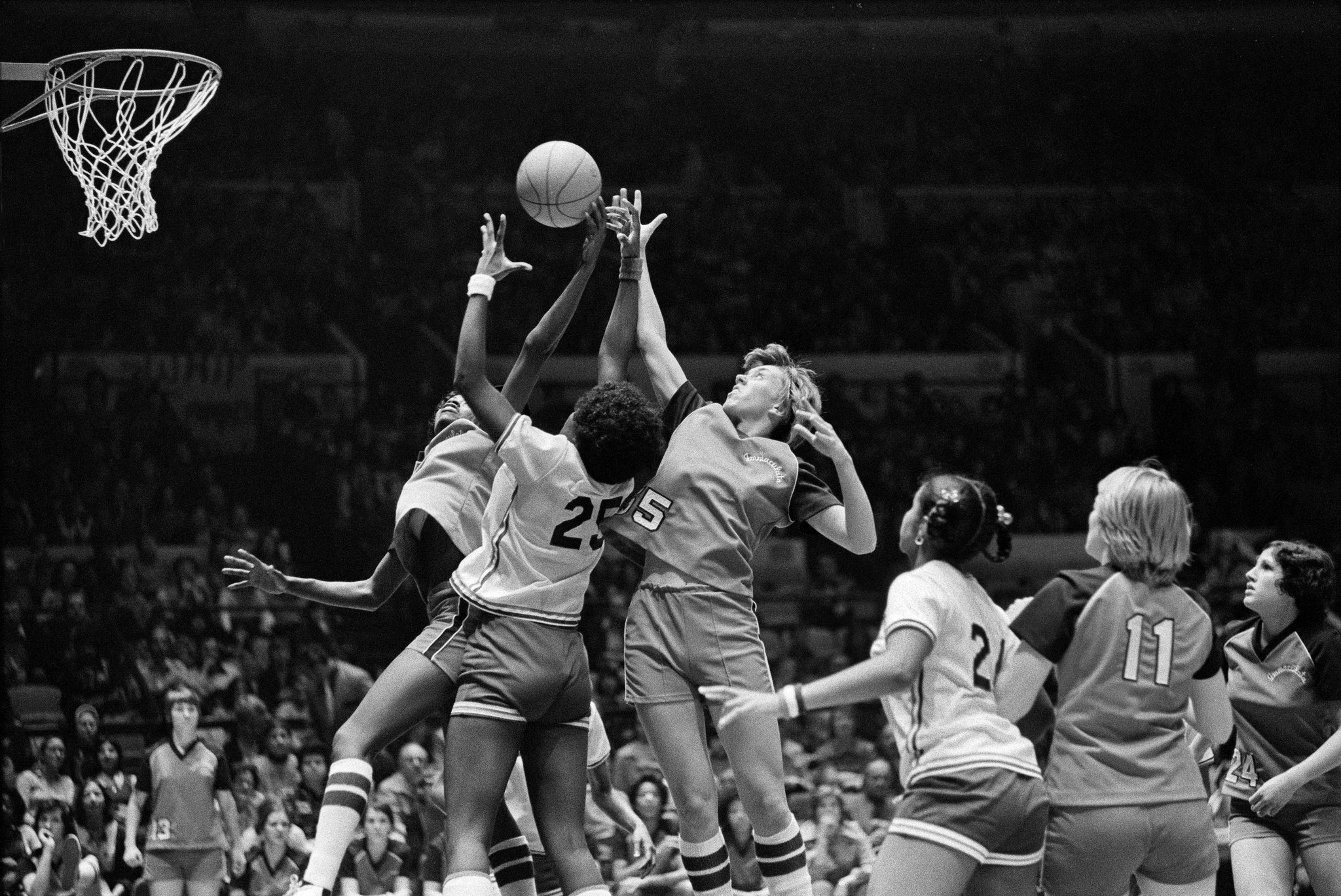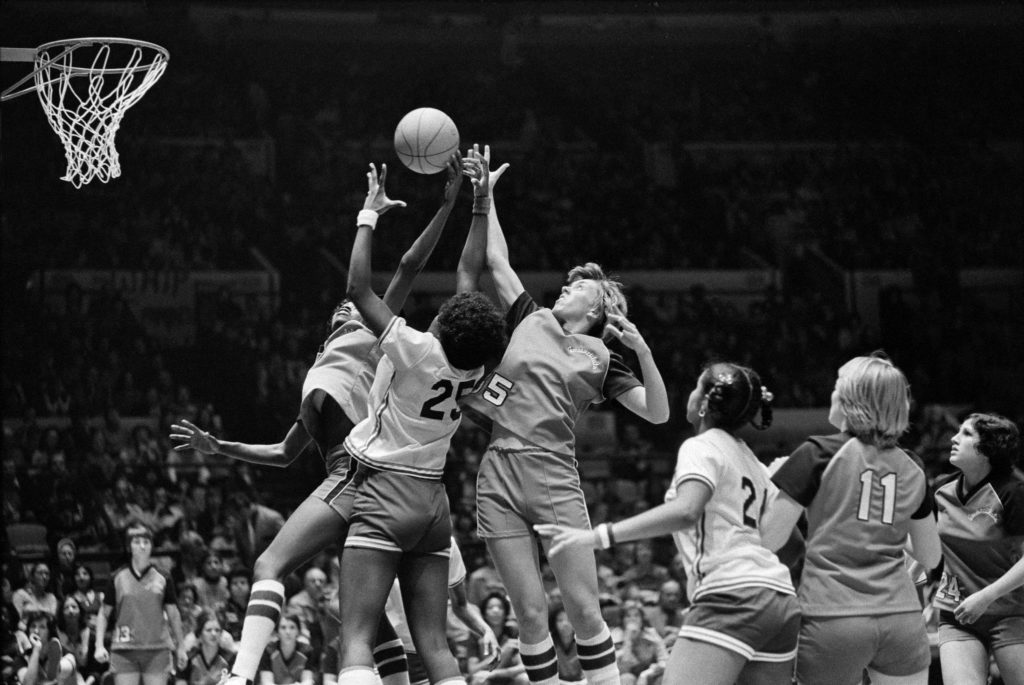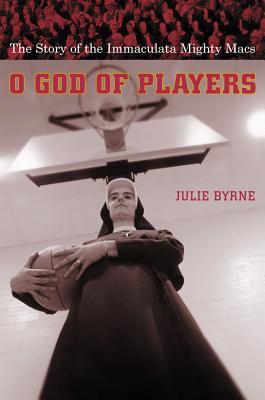O God of Players

Do you know what I did yesterday instead of writing this blog? I went to the Philadelphia parade for the Villanova basketball team, who had just won the NCAA men’s championship. Even if you don’t follow college athletics, you probably saw pictures of Sister Jean, Loyola of Chicago’s chaplain. The Catholic factor was prominent in the coverage of the Final Four, even in an article in the New York Times that began, “Long before a 98-year-old nun became the biggest star of the 2018 N.C.A.A. men’s basketball tournament, Immaculata, a small Catholic college outside Philadelphia, won the first three de facto national women’s basketball championships.”
YES! The author, Marc Tracy, had done his homework to expand the Catholic angle to include women as players, interviewing Julie Byrne, among others. This morning I searched out a review I wrote for Equal wRites, the publication of the Southeastern Pennsylvania Women’s Ordination Conference. Here it is, slightly modified.

Immaculata College, here beating Queens in the first women’s college basketball game at Madison Square Garden in 1975. Joyce Dopkeen/The New York Times
How weird, I thought. Living in Vermont, coming from New Jersey, I could not imagine how a small Catholic women’s college managed to win the first national basketball championship in 1972—and then went on to win two more—and then seemed to drop out of contention. At that time I did not understand Philadelphia Catholicism—but I do now. And Julie Byrne’s O God of Players: The Story of The Immaculata Mighty Macs (2003) explains the remarkable achievement by placing it in the context of a whole culture I so often see as detrimental to women. This is a good corrective.
Basketball was no post-sixties phenomenon for these women, no result of Title IX. Byrne describes the importance of the game to Philadelphia’s Catholic working class population, with leagues that began in the late 1910s of parish, CYO, high school and eventually college teams for boys at first and soon girls. Cardinal Dougherty and Monsignor Bonner saw physical education as part of the “wholeness” that they hoped the vast parochial school system would promote. And the girls ran with it and loved it. A hard, physical game was fun for them, just like the boys. They learned from their brothers and competed with them. These girls were tough and aggressive.
 Byrne confirms David Contosta’s class analysis in his article, “The Philadelphia Story: Life at Immaculata, Rosemont, and Chestnut Hill” in Catholic Women’s Colleges in America, edited by Tracy Schier and Cynthia Russett (2002). Contosta devotes only a paragraph to athletics. Byrne uses basketball to explain the way some working class students carved out a space for themselves in an institution that might otherwise have been more elite. At Immaculata, most of the players were commuter students, not boarders. Byrne says that these girls “reversed the patterns of privilege” with their success at basketball, which became a focus for the whole school and often for the wider regional Catholic population. They loved being successful. They loved having fans. And they loved to win.
Byrne confirms David Contosta’s class analysis in his article, “The Philadelphia Story: Life at Immaculata, Rosemont, and Chestnut Hill” in Catholic Women’s Colleges in America, edited by Tracy Schier and Cynthia Russett (2002). Contosta devotes only a paragraph to athletics. Byrne uses basketball to explain the way some working class students carved out a space for themselves in an institution that might otherwise have been more elite. At Immaculata, most of the players were commuter students, not boarders. Byrne says that these girls “reversed the patterns of privilege” with their success at basketball, which became a focus for the whole school and often for the wider regional Catholic population. They loved being successful. They loved having fans. And they loved to win.
In addition to archival sources, Byrne’s study is based on interviews with women who played, coached, or cheered for Immaculata’s teams from the 1940s through the 1970s. This may limit some of the conclusions possible, especially in sensitive areas like sexuality. Homosexuality was not talked about. Players were not comfortable with nudity. “Femininity” was expected even as hard play was accepted. Marriage or becoming a nun ended their basketball careers.
Byrne characterizes the Sisters, Servants of the Immaculate Heart of Mary who staffed the school as more progressive before Vatican II and more conservative after, when compared with other religious orders. There was a conservative feeling about the various religious practices around the basketball team—prayers for success, wearing miraculous medals, affirmation of Catholic identity when playing non-Catholic schools. Byrne finds it hard to untangle these elements, and accepts that there was something “Catholic” about Immaculata basketball. Those involved did not seek to separate it out, but accepted it as the way things were.
Byrne answers questions we ask now that we did not ask at the time. Few black women were at Immaculata before 1970, and thus few were on the teams. The players enjoyed their travel and as their circle widened, used it to examine their assumptions—sometimes changing them, sometimes not. They remained white ethnics. They were “inadvertent feminists” who generally rejected feminist ideology but acted to support the choices of individual women. If you want to read about the glory years, all the detail is there, too. But you learn a lot more than basketball from O God of Players.
I concluded this review with the note that I was teaching at Temple University, “whose women’s basketball team was defeated by Immaculata in the 1946 Mythical City Championship game” (you have to read the book). The Times article concluded with the note that Phil Martelli, the coach of Philadelphia’s St. Joseph’s men’s basketball team, is married to Judy Marra, a player on the three championship teams. The reviews of Byrne’s book were good. My favorite quote is from Michael Pasquier.
An article in a 1974 issue of Sports Philadelphia asked the question: “How many men are on Philadelphia’s best basketball team?” Answer: “None.” In fact, there had not been any men on Phillie’s best basketball team since 1972, when the women’s basketball team of Immaculata College won the first of three national women’s college basketball championships.
I wonder if they had any parades through the city for the women.
Thanks to Marian Ronan for suggesting I review Byrne’s book and to Marjorie Jones for sending me the Times article.

3 Responses
Good story, but it is too much about feminism and Christ is not even mentioned. The person of Christ must be central to everything we do and everything we say about the ordination of women.
I hear that Pope Francis is planning to release some document about holiness on Monday. Can we show that the exclusively male priesthood is an obstacle to grace, and therefore an obstacle to holiness?
For instance, it seems clear to me that the exclusively male priesthood makes invisible the feminine genius in Christ. How can we best explain that this is an obstacle to the universal vocation to holiness?
This is so great – what fascinating material –
Great article, Regina! I wonder why North Jersey, which arguably had about as many Catholics from as many ethnic backgrounds as Philadelphia, never developed any CYO or Catholic School sports for women. At least, none that I was ever aware of in the 1960s, when I would have leapt at the chance to get to play competitive sports.